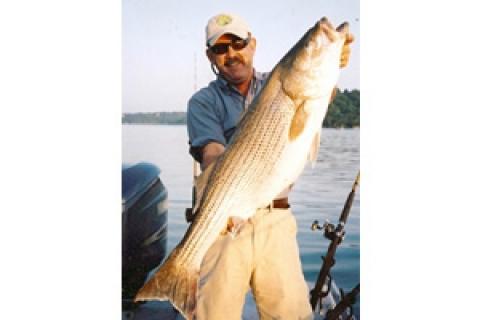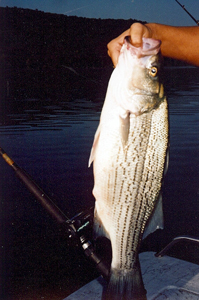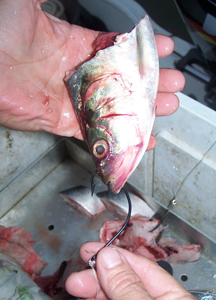
One of our nation's hardest fighting fish is the hybrid striped bass, which congregate in the free-flowing tailrace waters below major reservoir dams while answering nature's false call for the spring spawn.
 |
| Hybrid striped bass are a cross between the much larger striped bass and a white bass. |
"Wiper" mania has swept across the United States in less than four decades. The wiper, or hybrid striped bass, is a cross between a white bass and a striped bass. Biologists interested in the best qualities of both fish imagined a cross that might produce a fish that would feed on the over abundance of shad in the major reservoirs which quickly grew too large for white bass to consume.
The interest came about as a result of seafaring striped bass, which enter fresh water to spawn, being trapped behind the Cooper and Kerr Reservoir dams when they closed 45 years ago. To the amazement of anglers and biologists alike, stripers adapted to their new environment.
"The result of the white bass-striper cross was a fish that could both utilize the targeted shad populations and provide a great sport fish for anglers," said Trish Yasger, a fisheries management biologist with the Missouri Department of Conservation.
Hybrids can be caught throughout the year in the open waters of the major reservoirs. However, some of the hottest action of the year comes in the spring when the hybrids make false spawning runs up rivers and streams along with white bass. Dams on the major rivers block the ascent of these fish. As a result, large numbers of hybrids pile up in the tailwaters below the dams providing anglers a hybrid fishing Mecca.
The tailwaters of Truman Dam, in west-central Missouri, are one of the finest hybrid-striped bass fisheries in the country. These tailwaters have a reputation of producing "bruiser" class hybrids. In 1986, just six years after hybrids were first stocked in Missouri waters, Richard Slabaugh caught a 20-pound, 8-ounce hybrid below Truman Dam.
Truman's tailwaters stretch miles below the no fishing zone at the dam all the way to Lake of the Ozarks. Hybrids can be caught the entire length of the tailwater stretch. However, it is the waters nearest the dam that attract the most attention.
 |
| Hybrid bass are common across the United States and can be found in dozens of lakes and streams. |
Much of the water below the no-fishing zone is accessible to bank fishermen. However, heavy-duty equipment is needed to fish these waters. Serious hybrid fishermen use fishing rods in the 10-to-13-foot class. The big rods are necessary to heave big lures to the middle of the tailrace, where spring hybrids congregate. Casts of 120 to 150 yards are often necessary to reach fish-holding areas. The big rods also help absorb the shock when a hybrid makes the vicious strike for which they are known.
Anglers often use regular bass fishing equipment when hybrids are schooling closer to the bank. On the other hand, an 8-foot spinning or casting rod, armed with a matching fishing reel spooled with 12-pound-test line, is the minimum which can be used for consistent success. If there is a weak link in your equipment, a hybrid will quickly point it out.
Hybrid fishing is very dependent on water flow and temperature. Water temperature of 45 degrees seems to be optimum. Colder water scatters the fish. Temperatures remain constant enough to hold hybrids in the Truman tailrace January through June.
The spawning season brings two runs to Truman tailwaters. The first run of smaller fish, from 5-to-12-pounds, typically swim with white bass about the middle of March until the middle April. Fishermen who prospect early, however, may find some fabulous fishing in the deeper holes downstream from the dam.
The bigger hybrids, up to 20-pounds, run later in April and May. The full moon of May is the best time for fishing the second run.
An abundant shad population helps hold hybrids in Truman tailwaters. Lures which imitate shad are the most popular. Steve Blake, a veteran hybrid fishing guide, suggests a 5-inch Mister Twister Curly Tail Grub in white or chartreuse on a leadhead jig of at least a half-ounce.
"Cast upstream and keep bumping the jigs off the bottom," Blake said. He also pointed out that topwater hardbaits can provide some heart throbbing action at times. "Early and late in the day can be great for hybrids, especially if generators aren't running. A Zara Spook works well." Lucky Craft stick baits will produce, too.
 |
| Cut shad is a favorite bait used by hybrid fishermen. The oily fish leaves a good scent trail in moving water. |
Jigging spoons, up to 3-ounces in weight, are also very popular hybrid lures. Deep-diving crankbaits such as STORM'S Wiggle-Warts and Bomber's Switchback Shad also produce fish. For clear water, try a suspending a Smithwick Rattlin' Rogue in a blue-and-chrome-finish; for dingy water, use the same lure with a red head and a gold body. Strike Kin's A-Series crankbaits and Wake Shad are other favorites, as is the Lucky Craft Bevy Shad.
Blake suggested using cut bait for extremely dingy water. "Cut shad is great hybrid bait," he said. "It is very oily and leaves a good scent trail in moving water. Also, I like to add a small sliver of cut shad to my jigging spoons. This rig provides flash from the spoon, smell from the shad and a piece of meat or the hybrid to eat."
Jeff Purcell, with the Missouri Department of Conservation, also suggests that anglers use shrimp or chicken livers for hybrids. "Catfishermen discovered that they can catch hybrids on the same baits they use for catfish. Hybrids seem to be real suckers for chicken livers."
Fishing for hybrid striped bass is here to stay. Lakes and their tailwaters abound across the U.S. From Allatoona Lake in Cartersville, Georgia to Willow Creek in Near Pierce, Nebraska, hybrid fishing is not far from most Americans. Some of the top hybrid lakes include: Lake Seminole, Florida; West Point Lake, Georgia; Heidecke Lake, Illinois; Texoma Lake, Oklahoma; Sam Rayburn Lake, Texas; and Beaver Lake, Arkansas.
If you are up for some tackle busting fishing action, head to your nearest tailwater hybrid fishery. Talk to bait shop owners to get the lowdown on the tactics that work best in your given area. Your first hybrid striped bass will provide a lifetime memory.
And if you like hybrid fishing, after the tailwater fishing slows down towards summer, hybrids can be caught in the main lake. But that's another story!
- 62861 views

